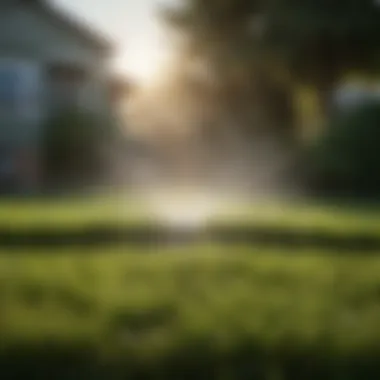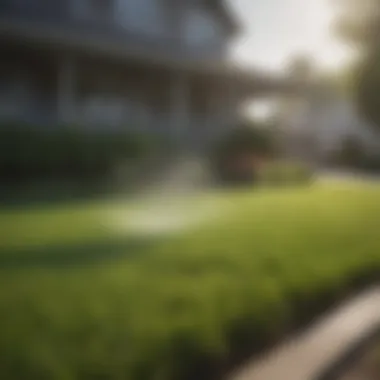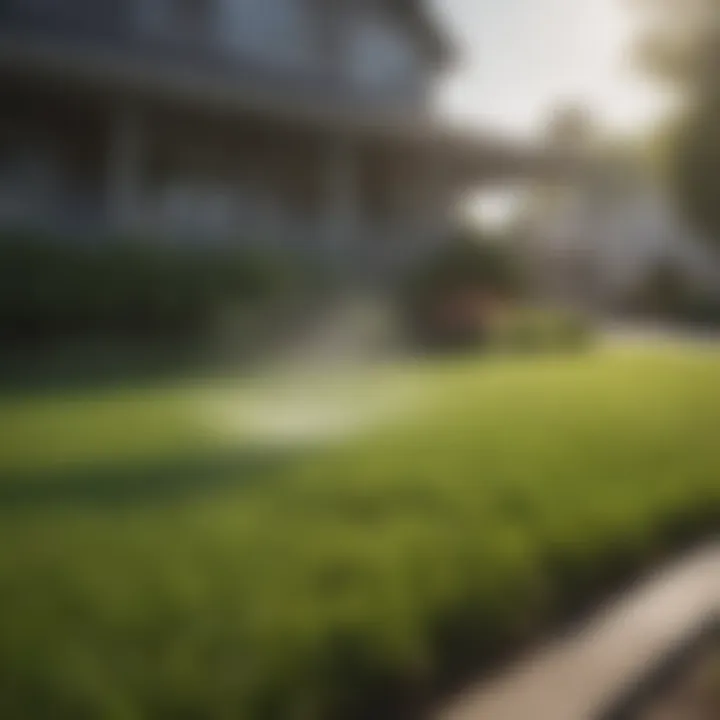Optimal Timing for Lawn Irrigation: Best Practices


Intro
Watering your lawn is not just a routine chore; it is a practice that can dramatically influence the health and appearance of your yard. A well-timed irrigation schedule can promote robust growth and prevent disease, making the understanding of optimal watering techniques essential for homeowners and gardening enthusiasts. In this comprehensive analysis, we will explore the best times to irrigate your lawn by examining critical factors such as weather, soil types, and grass species.
When it comes to lawn health, the timing of irrigation stands as a pivotal consideration. Different regions and climates may dictate different needs, yet some fundamental principles hold true universally. This guide will delve into these principles, offering practical insights and dispelling common misconceptions that often surround lawn watering. Our aim is to equip you with the necessary knowledge to maintain a healthy lawn while optimizing water usage, an increasingly important consideration in a world facing water scarcity.
Design Inspiration
Finding a balance in an irrigation regimen is crucial. While it might not seem as artistic as landscape design, the aesthetics of a well-maintained lawn can inspire the unique designs and layouts of outdoor spaces. Understanding the nuances of lawn watering can serve as inspiration for a beautifully maintained environment.
Trending Styles
The current trend emphasizes sustainable landscaping. Homeowners are opting for drought-resistant plants and grasses that require less frequent watering. For instance, native grasses are becoming increasingly popular due to their resilience and lower water requirements. These choices not only benefit the environment but also reduce water consumption significantly.
Color Palettes
A lush green lawn contributes to a harmonious visual experience in landscaping. By selecting grasses that thrive in your local climate, you create a palette that enhances the overall beauty of your garden. Choosing deep green varieties, such as Kentucky bluegrass or fescue, can provide a vibrant backdrop for colorful flower beds. In regions with more sunlight, patches of Bermuda grass can stand out beautifully with their lighter green shade, creating a dynamic visual effect in your outdoor area.
Practical Tips
Understanding your unique environment will enhance your watering strategy, ensuring your lawn remains healthy while conserving water.
Maintenance & Care
- Soil Testing: Regular soil testing helps determine the moisture level and nutrient content. Knowing your soil can inform how often to water.
- Grass Height: Keeping lawn grass at an optimal height allows for deeper root systems. Longer grass retains moisture better than shorter grass.
- Irrigation Systems: Consider installing a smart sprinkler system that adjusts the watering schedule based on weather conditions. This can save time and water, promoting an efficient irrigation approach.
Budgeting & Planning
Setting a budget for lawn care should include considerations for water usage. Reducing irrigation frequency can lower water bills. Planning ahead for seasonal changes in climate helps prevent overspending on water resources. Additionally, creating a schedule around local weather forecasts adds a valuable layer of responsiveness to your watering practices.
"Water conservation is not just a trend; it is a necessity in our changing climate."
By following these practical tips and understanding the underlying science behind watering, homeowners can optimize their watering schedules, ensuring they nurture a healthy and visually appealing lawn.
Understanding the Importance of Watering Timing
Understanding when to water is critical for maintaining a healthy lawn. The timing of irrigation not only influences grass health but also impacts water conservation efforts. These two aspects are fundamentally connected and should be recognized by every homeowner who wishes to cultivate a flourishing green space.
Impact on Grass Health
The health of grass is directly linked to the timing of watering. Watering at the wrong time can lead to various problems. For instance, watering during the peak sun hours often causes rapid evaporation of water. This means less moisture reaches the roots, which can hinder grass growth and lead to weak, unhealthy plants. Conversely, early morning watering allows grass to absorb moisture before the heat of the day. In this way, the grass can utilize water more effectively and thrive.
In addition, watering during the evening can create conditions that promote fungal growth. This occurs because grass blades might stay wet throughout the night, leading to increased risk of diseases. Therefore, a strategic approach to watering can contribute significantly to the overall health of grass.
Water Conservation Strategies
Water conservation is becoming increasingly important in our modern landscape. Efficient watering strategies can aid in reducing overall water use while ensuring that lawns remain healthy. Notable strategies include:


- Irrigation Scheduling: Knowing the best time to water, such as early morning, can significantly reduce water waste.
- Rain Sensors: Installing devices that prevent irrigation during rainy periods is an excellent way to save water.
- Soil Moisture Monitoring: Using tools like moisture meters can help gauge the need for watering and avoid unnecessary application.
Moreover, practices such as mulching and selecting drought-resistant grass types can further optimize water use. Adopting these strategies not only supports sustainability, it also complements community efforts towards eco-friendliness.
"The right timing for watering can change the sustainability of your lawn."
Factors Affecting Lawn Watering Times
Understanding the optimal timing for lawn watering requires a nuanced look at several interrelated elements. These factors not only influence the effectiveness of irrigation but also affect the overall health of lawns and contribute to water conservation efforts. The three primary considerations in determining when to water are climate and weather conditions, soil composition, and the type of grass growing in the lawn. Each of these factors plays a vital role in shaping an appropriate irrigation schedule, thus ensuring a vibrant and healthy lawn while minimizing waste.
Climate and Weather Conditions
Climate and weather conditions are perhaps the most influential factors in deciding when to irrigate your lawn. Different regions experience varying climates. For instance, areas with high humidity may require less frequent watering than arid regions. Factors like temperature and humidity also significantly impact how quickly moisture evaporates from the lawn. During hot summer days, water evaporates more quickly, which means it may be necessary to water more frequently and at specific times to ensure the soil retains moisture.
Another critical aspect is precipitation. Keeping track of rainfall is essential. If there has been recent heavy rain, additional watering may be unnecessary. It is advisable to use a rain gauge or check local weather forecasts. This helps ensure that you do not overwater your lawn, contributing to both unnecessary water usage and potential damage to your grass.
Soil Composition
Soil composition directly impacts how well your lawn retains moisture. Different soils have different capacities for holding water. Sandy soils, for instance, drain quickly and do not retain water well, necessitating more frequent watering. Conversely, clay soils hold more water but can create problems if watered too much, leading to poor drainage and root disease.
Furthermore, the presence of organic matter in the soil also plays a role. Soils rich in organic matter have improved structure and can hold moisture better than those with less humus. Testing your soil composition periodically can provide valuable insights into watering needs. You might consider adding compost or other organic materials to improve water retention.
Type of Grass
The type of grass you have in your lawn also dictates when and how much you should water. Cool-season grasses, such as Kentucky bluegrass, thrive in cooler temperatures and require more water during the warmer months. On the other hand, warm-season grasses like Bermuda grass need less water and will be more tolerant of drier conditions.
Additionally, knowing your grass type allows you to tailor your watering schedule around its specific needs. For instance, during the hot summer months, warm-season grasses benefit from deep watering less frequently, while cool-season grasses may require more regular watering to maintain their health.
Best Times of Day for Watering Lawns
Determining the ideal times of day for lawn watering is crucial for maintaining a healthy and lush lawn. Understanding these timings can lead to effective irrigation strategies that not only promote grass health but also optimize water use. Homeowners and gardening enthusiasts must consider various factors, including environmental conditions and the physiological needs of grass, to make informed decisions about their watering schedule.
Early Morning Advantages
Watering in the early morning yields numerous advantages. During this time, temperatures are generally cooler, which limits evaporation. Cooler weather allows the water to penetrate the soil more deeply, reaching the roots effectively. This practice helps grass absorb moisture efficiently, promoting stronger growth.
Additionally, watering in the early morning can ward off disease. Grass blades will dry out as the sun rises, reducing the chance of fungal infections. This timing also aligns well with the natural biological processes of grass, which tend to thrive with morning hydration. It is advisable to start watering between 5 a.m. and 10 a.m. for optimal results.
Midday Watering Challenges
Watering during midday presents several challenges that can undermine the effectiveness of the practice. The primary concern is the high rate of evaporation. As temperatures peak, a significant portion of water can vaporize before it reaches the roots, leading to inadequate moisture retention in the soil.
Moreover, watering during these hours places additional stress on grass. The hot sun can scorch water droplets on leaves, causing harm rather than benefit. This situation often results in uneven watering patterns, leading to the problem of some areas becoming over-saturated while others remain dry. It's generally recommended to avoid watering when the sun is the strongest, typically from 10 a.m. to 4 p.m.
Evening Watering Considerations
Evening watering has its own set of considerations. While it may seem convenient, watering late in the day can hamper the grass's ability to dry before nightfall. Prolonged wetness on the grass blades overnight creates a perfect environment for diseases and pests to thrive.
However, if early morning watering is not feasible, scheduling watering in the early evening may serve as an alternative. It is important to note that this should ideally be done a few hours before sunset to allow for some evaporation. This method can ensure that the moisture reaches the soil effectively while minimizing the risk of disease.


In summary, the best time for lawn watering is early morning, followed by a cautious approach in the evening. Avoiding midday watering is critical due to high evaporation rates and potential damage to grass health. By understanding and implementing these strategies, homeowners can achieve a thriving and sustainable lawn.
Watering Techniques and Tools
Choosing the right watering techniques and tools can make a significant difference in achieving optimal lawn irrigation. The method of watering influences water distribution, efficiency, and overall grass health. Understanding various options allows homeowners to select the most suitable approach for their specific lawn care needs.
Sprinkler Systems
Sprinkler systems are a common choice for lawn irrigation. They offer automated and timed watering, making it easier to maintain consistency. There are different types of sprinkler systems, such as stationary, oscillating, and rotary sprinklers. Each type has its unique benefits. Stationary sprinklers are great for small areas, while oscillating and rotary systems cover larger spaces more evenly.
Some advantages of sprinkler systems include:
- Efficiency: Automated timers enable precise scheduling, reducing water waste.
- Coverage: Properly installed systems can cover the entire lawn uniformly.
- Flexibility: Adjustable heads allow you to control the range of water distribution.
However, there are considerations to keep in mind with sprinkler systems. They can be more complex to install and may require regular maintenance. Additionally, timing is crucial; watering during the late morning or early evening minimizes evaporation, which is essential for optimal water usage.
Soaker Hoses
Soaker hoses represent another effective watering method. They are porous hoses that release water gradually along their length, allowing moisture to penetrate deeply into the soil. This technique reduces water runoff and evaporation, making it an eco-friendly choice. Soaker hoses are particularly useful for garden beds and specific plant zones.
Benefits of using soaker hoses include:
- Efficiency in Water Use: They deliver water directly to roots while minimizing surface evaporation.
- Easy Installation: Simply lay them out in desired areas; no complex installation is necessary.
- Maintenance: Generally low-maintenance compared to traditional sprinkler systems.
However, the proper positioning is vital. It may take time to determine the ideal layout for your lawn to ensure all areas receive adequate moisture.
Manual Watering Methods
Manual watering remains a feasible option for many homeowners. Using a garden hose with a spray nozzle allows more control over water application. This method suits small lawns or specific patches of grass that require extra attention.
Key aspects of manual watering include:
- Control: Homeowners can decide where and how much water to deliver, preventing overwatering.
- Cost: Manual methods usually require fewer investments than installations or equipment.
- Connection to the Environment: This method allows for active engagement with the lawn and an understanding of its specific needs.
However, it can be labor-intensive and time-consuming. Homeowners need to ensure they are watering at optimal times, ideally early in the morning or late afternoon to enhance absorption.
"Efficient watering methods not only improve grass health but also conserve essential water resources."
Common Misconceptions about Lawn Watering
Understanding the common misconceptions regarding lawn watering is vital for homeowners aiming to maintain a healthy lawn. Misconceptions often lead to improper watering practices that can negatively impact grass health and water usage. Addressing these myths allows for informed decisions and promotes effective strategies for lawn maintenance.
Night Watering Myths
One prevalent myth is that watering at night is always beneficial. Many homeowners believe that nighttime irrigation helps minimize evaporation losses. While it is true that less water evaporates during cooler night temperatures, there are significant downsides to consider.
Watering in the evening may leave grass blades wet for extended periods, creating an environment conducive to diseases like fungal infections. Turf that remains moist overnight is more susceptible to these issues, especially in humid climates. Thus, although nighttime watering may seem efficient, it can lead to the opposite effect on lawn health.
"Watering practices should prioritize grass health and environmental conditions, rather than convenience or assumption."


Another important factor is the landscaping setup. Trees, shrubs, and other plants can obstruct airflow and restrict evaporation, increasing the likelihood of disease. Homeowners should be aware of their specific circumstances before adopting this practice.
Overwatering Beliefs
Another misconception revolves around overwatering beliefs. Many people think that watering more often guarantees a lush, green lawn. However, this perspective may lead to significant problems.
Overwatering can suffocate the roots, depriving them of necessary oxygen. It can also lead to shallow root systems, as grass becomes reliant on consistent water rather than developing characteristics necessary for drought resilience. The signs of overwatering can be misleading, often mistaken for those of drought stress.
Homeowners should consider these factors when creating their watering schedules:
- Soil Type: Sandy soils require more frequent watering than clay soils.
- Grass Type: Different grasses have varying water needs.
- Seasonal Changes: Adjustments based on temperature and rainfall are important.
Thus, the belief that more water equals a healthier lawn is flawed. Homeowners must apply a more nuanced understanding of their grass' needs and their local environment to ensure optimal growth. Remember, balance is key to maintaining a thriving lawn.
Environmental Considerations in Lawn Watering
Understanding the environmental implications of lawn watering practices is crucial for any homeowner or gardening enthusiast. Proper irrigation not only benefits your lawn but also protects local ecosystems and promotes sustainable practices. An awareness of how water usage affects the environment can help you make informed decisions, ultimately leading to a healthier landscape.
Impact on Local Ecosystems
Watering practices can significantly influence local ecosystems. Over-irrigating can lead to water runoff, which may carry fertilizers, pesticides, and other chemicals into nearby water bodies. This runoff can cause algal blooms that deplete oxygen levels and harm aquatic life. Conversely, under-watering can stress plants, making them less resilient to pests and diseases, potentially leading to the use of more chemicals in the long run.
To minimize negative impacts, homeowners should strive for a balanced approach to watering. Utilizing rainwater harvesting systems can be a practical solution, allowing you to collect natural rainfall and use it for your lawn. Furthermore, selecting native and drought-resistant plants can reduce the overall need for watering. Incorporating these strategies can enhance the health of local habitats and contribute to biodiversity.
Sustainable Practices
Adopting sustainable watering practices is integral to responsible lawn maintenance. These practices not only conserve water but also benefit the environment in multiple ways.
- Soil Health: Healthier soil can absorb more water, reducing the need for frequent watering. Practices such as mulching and composting improve soil structure and moisture retention.
- Efficient Water Use: Drip irrigation systems and soaker hoses deliver water directly to the plant roots, minimizing waste and evaporation.
- Climate Awareness: Being aware of local climate conditions aids in optimizing your irrigation schedule. Adjusting watering times based on forecasted rainfall or seasonal changes can save resources.
- Water Auditing: Regularly evaluating your watering system can help identify leaks and inefficiencies. Making necessary adjustments ensures you are not applying excessive water to your lawn.
Incorporating these practices not only conserves water but also sets a precedent for responsible gardening. By making small changes, homeowners can significantly ease the pressure on local water sources and demonstrate stewardship of their environment.
Ending: Strategic Lawn Watering
In concluding this comprehensive analysis, strategic lawn watering emerges as a critical factor in maintaining overall lawn health and optimizing water resources. Understanding optimal timings for irrigation provides homeowners, gardeners, and landscaping enthusiasts with actionable insights. Properly timed watering not only promotes robust grass growth but also helps in conserving valuable freshwater resources.
Implementing Best Practices
Implementing best practices for lawn irrigation begins with setting a consistent schedule. This involves considering factors like local climate, specific grass types, and prevailing soil conditions. For many homeowners, early morning watering is most effective. It minimizes evaporation and allows grass to absorb moisture efficiently. Adjustments based on rainfall patterns and humidity levels are also paramount.
Some key practices to consider include:
- Using Smart Irrigation Systems: Equip your lawn with smart controllers that adjust watering based on current weather data. These systems can detect rainfall and modify schedules accordingly, saving water while ensuring your lawn stays hydrated.
- Monitoring Soil Moisture: Regularly check soil moisture levels to gauge whether watering is necessary. Tools such as a soil moisture meter can aid in making informed decisions.
- Adjusting Water Amounts: During heat waves or dry spells, consider increasing the watering duration. Conversely, reduce watering during cooler months or periods of significant rainfall to prevent oversaturation.
Adjusting to Seasonal Changes
Adjusting the irrigation practices according to seasonal changes further enhances lawn health. Different seasons present unique challenges and opportunities. In spring, for instance, lawns typically require less water due to cooler temperatures and higher precipitation. As summer approaches, homeowners should gradually increase watering frequency to combat heat stress on grass.
Seasonal adjustments can include:
- Monitoring Temperature Fluctuations: Higher temperatures warrant more frequent checking of soil moisture levels. If temperatures rise unexpectedly, be prepared to alter your schedule.
- Understanding Growth Cycles: Different grass types exhibit varying growth patterns. Cool-season grasses thrive in spring and fall, while warm-season grasses prefer summer heat. Schedule watering to match the active growth periods of your chosen grass type.
- Preparing for Winter: As seasons transition to winter, reduce watering frequency, allowing the grass to enter dormancy naturally. However, ensure that the lawn is adequately hydrated before cold temperatures set in, to promote resilience following winter.
Effective lawn watering is not simply about maintaining aesthetics. It is about improving sustainability for our environment while ensuring the longevity of your lawn.
By embracing strategic lawn watering tailored to specific conditions, homeowners can foster healthier lawns and contribute positively to environmental conservation. Understanding when and how to water empowers individuals in creating lush landscapes while being responsible water stewards.















